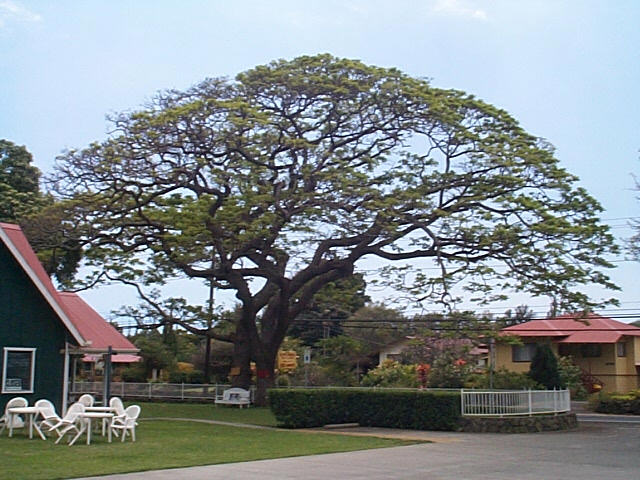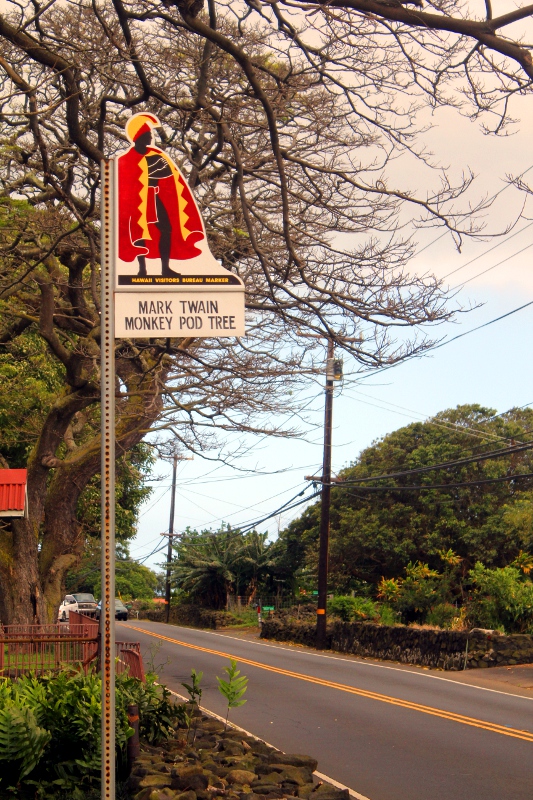
In 1866 a 31-year-old Mark Twain spent four months in Hawaii. Three of those months were spent on the Big Island where Twain rented a horse and “Ransacked the island” for his dispatches back to the Sacramento Daily Union on the mainland. In June of 1866 he visited Ka’u and planted a Monkeypod tree in Waiohinu, the second generation of which can still be seen today. Waiohinu is tiny and to call it a “town” is being generous. Once a thriving sugar cane community, today Waiohinu has very little in the way of attractions. Mark Twain’s Monkey Pod is about it, and worth a pull over as you drive through if for nothing else than to stand and reflect in the spot where one of the country’s most beloved writers stood 150 years ago.

He mentions his time in Waiohinu in his letter published in the Sacramento Daily Union on October 25, 1866
“All day the next day we fought that treacherous point – always in sight of it but never able to get around it. At night we tacked out forty or fifty miles, and the following day at noon we made it and came in and anchored.
We went ashore in the first boat and landed in the midst of a black, rough, lava solitude, and got horses and started to Waiohinu, six miles distant. The road was good, and our surroundings fast improved. We were soon among green groves and flowers and occasional plains of grass. There are a dozen houses at Waiohinu, and they have got sound roofs, which is well, because the place is tolerably high upon the mountain side and it rains there pretty much all the time. The name means “sparkling water,” and refers to a beautiful mountain stream there, but they ought to divide up and let it refer to the rain also.
A sugar plantation has been started at Waiohinu, and 150 acres planted, a year ago, but the altitude ranges from 1,800 to 2,500 feet above sea level, and it is thought it will take an other year for the cane to mature.
We had an abundance of mangoes, papaias and bananas here, but the pride of the islands, the most delicious fruit known to men, cherimoya, was not in season. It has a soft pulp, like a pawpaw, and is eaten with a spoon. The papaia looks like a small squash, and tastes like a pawpaw.
In this rainy spot trees and flowers flourish luxuriantly, and three of those trees – two mangoes and an orange – will live in my memory as the greenest, freshest and most beautiful I ever saw – and withal, the stateliest and most graceful. One of those mangoes stood in the middle of a large grassy yard, lord of the domain and incorruptible sentinel against the sunshine. When one passed within the compass of its broad arms and its impenetrable foliage he was safe from the pitiless glare of the sun – the protecting shade fell everywhere like a somber darkness.
In some places on the islands where the mango refused to bear fruit, a remedy suggested by the Scientific American has been tried with success. It consists in boring a hole in the trunk of the tree, filling the same with gunpowder and plugging it up. Perhaps it might be worth while to try it on other fruit trees.”
The Mark Twain Monkeypod is clearly labled by a Hawaiian warrior sign on the mauka (mountain) side of the road as you first enter Waiohinu.
